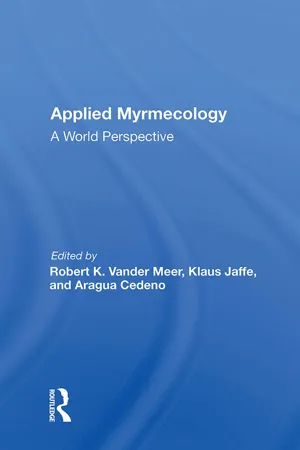
- 744 pages
- English
- ePUB (mobile friendly)
- Available on iOS & Android
About This Book
Ants have always fascinated the nature observer. Reports from ancient Egypt and Mesopotamia indicate that ants interested humans long ago. Myrmecology as a science had its beginning in the last century with great naturalists like Andre, Darwin, Emery, Escherich, Fabre, Fields, Forel, Janet, Karawaiew, McCook, Mayr, Smith, Wasmann and Wheeler. They studied ants as an interesting biological phenomenon, with little thought of the possible beneficial or detrimental effects ants could have on human activities (see Wheeler 1910 as an example). When Europeans began colonizing the New World, serious ant problems occurred. The first reports of pest ants came from Spanish and Portuguese officials of the fifteenth and sixteenth centuries in Trinidad, The West Indies, Central America and South America. Leaf-cutting ants were blamed for making agricultural development almost impossible in many areas. These ants, Atta and Acromyrmex species, are undoubtedly the first ants identified as pests and may be considered to have initiated interest and research in applied myrmecology (Mariconi 1970).
Frequently asked questions
Information
Table of contents
- Cover
- Half Title
- Series Page
- Title
- Copyright
- Contents
- Foreword
- Preface
- Acknowledgments
- ANT PESTS OF THE WORLD
- 1. Major ant problems of South America
- 2. Pest ants of India
- 3. Pest ants in urban and agricultural areas of southern Africa
- 4. Seed harvesting ant pests in Australia
- 5. Pest ants in the Hawaiian islands
- 6. Ants that have pest status in the United States
- SYSTEMATICS AND MORPHOLOGY
- Overview
- 7. Chemotaxonomy applied to fire ant systematics in the United States and South America
- 8. A survey of the glandular system of fire ants
- 9. A comparison of venom and hydrocarbon profiles from alates in Texas monogyne and polygyne fire ants, Solenopsis invicta
- 10. Cephalic exocrine glands of ants: a morphological view
- 11. Morphology of the digestive tract and associated excretory organs of ants
- REPRODUCTION
- Overview
- 12. Reproductive strategies of the fire ant
- 13. Oviposition and growth of the fire ant
- 14. Social control of reproduction in fire ant colonies
- 15. Egg-laying in
- 16. Foundress female weight and cooperative foundation in Atta leaf-cutting ants
- NATURAL HISTORY AND BIOLOGY
- Overview
- 17. Evolution of ant communities in response to invasion by the fire ant
- 18. Community structure and
- 19. A decade-long study of an Attine ant colony
- 20. Development of the ant-fungus relationship in
- 21. Methods for estimating the population density of leaf-cutting ant colonies
- 22. Methods for the evaluation of leaf-cutting ant harvest
- 23. Seasonal activity of Atta insularis, an important citrus pest in Jaguey Grande, Cuba
- 24. Relative protection of
- 25. Invertebrate enemies and nest associates of the leaf-cutting ant
- 26. Biology of carpenter ants
- 27. The little fire ant
- 28. Biological aspects of the "hormiga loca,"
- 29. Ant pests of the Tapinomini tribe
- BEHAVIORAL AND CHEMICAL ECOLOGY
- Overview
- 30. Nestmate recognition in fire ants: monogyne and polygyne populations
- 31. Behavioral interactions of fire ants and their parasites, predators and inquilines
- 32. Territorial ecology of the leaf-cutting ant
- 33. Foraging strategies and vegetation exploitation in the leaf-cutting ant
- 34. Senses used by Acromyrmex subterraneus molestans during homing orientation, under laboratory conditions
- 35. The discovery of new resources and subsequent trail formation by
- 36. Factors controlling foraging patterns in the leaf-cutting ant
- 37. Foraging and fungal substrate selection by leaf -cutting ants
- 38. Toxic effect of plants on leaf-cutting ants and their symbiotic fungus
- 39. Pheromonal control of behavior in leaf-cutting ants
- 40. Self-organizing spatial patterns in the Argentine ant
- 41. Foraging of Pharaoh ants
- 42. Some findings on neurotoxins from the venom of the giant ant,
- 43. Prey capture strategy of the African weaver ant
- 44. The biological activities of ant-derived alkaloids
- APPLIED ECOLOGY
- Overview
- 45. Effects of the fire ant,
- 46. Red imported fire ants' (
- 47. Control of
- 48. Relationships between Argentine ants and honeybees in South Africa
- 49. Carpenter ants (
- 50. The biology and economic impact of
- 51. The role of ants in Australian land reclamation seeding operations
- 52. The ant problems of cocoa farms in Brazil
- 53. Ant assemblage structure and ecological management in citrus and subtropical fruit orchards in southern Africa
- CONTROL
- Overview
- 54. Chemical control of the imported fire ants
- 55. Effects of IGR fenoxycarb and Sumitomo S-31183 on the queens of two myrmicine ant species
- 56. Control of the red imported fire ant
- 57. Approaches to biological control of fire ants in the United States
- 58. Potential baits for control of the Texas leaf-cutting ant,
- 59. Comparison of susceptibility of
- 60. Psychotropic substances impairing the vigilance of
- 61. Controlling Argentine ants in urban situations
- 62. Health aspects and control of
- 63. Effects of fenoxycarb baits on laboratory colonies of the Pharaoh's ant,
- 64. Reducing theft of surface-sown seeds by harvester ants
- 65. Management of carpenter ants
- 66. Management of the "hormiga loca,"
- 67. Ant control in Hawaiian drip irrigation systems
- List of Contributors
- Taxonomic Index
- Subject Index